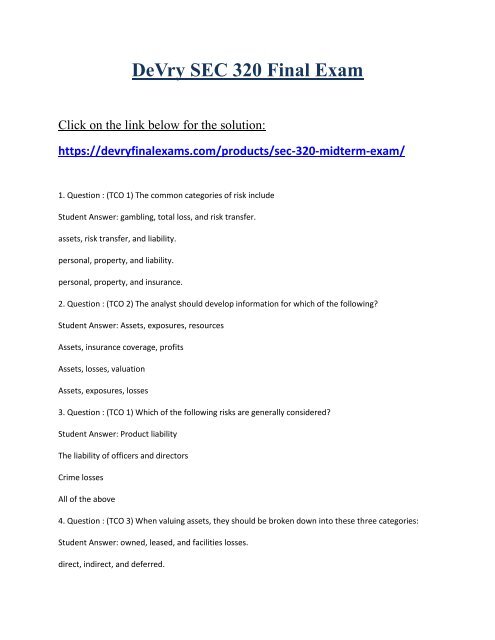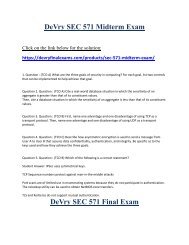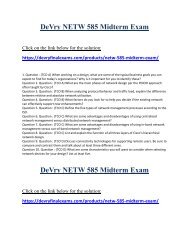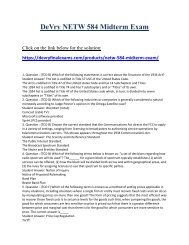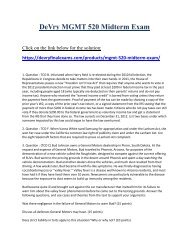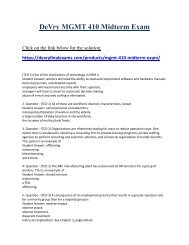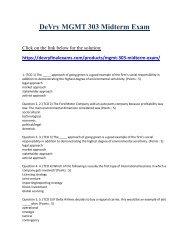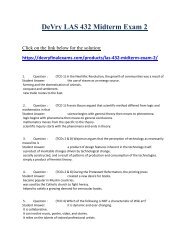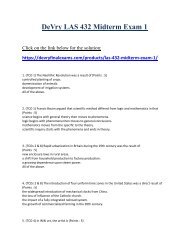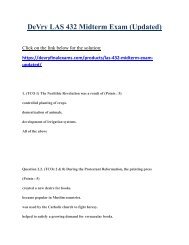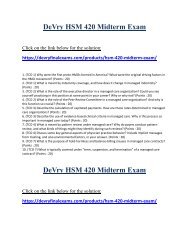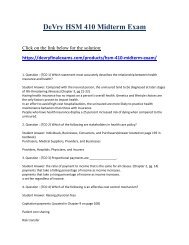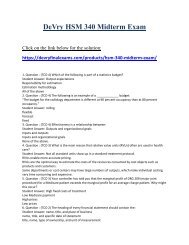SEC 320 Midterm Exam
Create successful ePaper yourself
Turn your PDF publications into a flip-book with our unique Google optimized e-Paper software.
DeVry <strong>SEC</strong> <strong>320</strong> Final <strong>Exam</strong><br />
Click on the link below for the solution:<br />
https://devryfinalexams.com/products/sec-<strong>320</strong>-midterm-exam/<br />
1. Question : (TCO 1) The common categories of risk include<br />
Student Answer: gambling, total loss, and risk transfer.<br />
assets, risk transfer, and liability.<br />
personal, property, and liability.<br />
personal, property, and insurance.<br />
2. Question : (TCO 2) The analyst should develop information for which of the following?<br />
Student Answer: Assets, exposures, resources<br />
Assets, insurance coverage, profits<br />
Assets, losses, valuation<br />
Assets, exposures, losses<br />
3. Question : (TCO 1) Which of the following risks are generally considered?<br />
Student Answer: Product liability<br />
The liability of officers and directors<br />
Crime losses<br />
All of the above<br />
4. Question : (TCO 3) When valuing assets, they should be broken down into these three categories:<br />
Student Answer: owned, leased, and facilities losses.<br />
direct, indirect, and deferred.
capital, expense, and budgeted.<br />
None of the above<br />
5. Question : (TCO 1) Probability is defined as<br />
Student Answer: a mathematical guess.<br />
the ratio of all probable outcomes to the number of attempts.<br />
the ratio of the number of favorable cases to all possible cases.<br />
the ratio of the number of unfavorable cases to all possible outcomes.<br />
6. Question : (TCO 2) In operational risk management, an example of a process can include<br />
Student Answer: intentional contamination of food.<br />
serving food to customers.<br />
the continuous evaluation of program effectiveness.<br />
the growth of a pathogen.<br />
7. Question : (TCO 2) How does the Vulnerability Self-Assessment Tool (VSAT) define vulnerability?<br />
8. Question : (TCO 1) Differentiate the best way to handle the following risks:<br />
high severity, high frequency; high severity, low frequency; medium severity, and a risk with a<br />
probability range of 4-6; low severity, high frequency; low severity, low frequency.<br />
9. Question : (TCO 3) When deciding to insure assets, risks must substantially meet certain requirements<br />
in order to be insurable. Name four requirements.<br />
10. Question : (TCO 2) Given an organization’s need to secure its assets and protect its personnel, for<br />
what purpose would it create a security survey?<br />
11. Question : (TCO 1) The principles of probability are very important to understand when determining<br />
risk. With respect to the primary principles, choose three and explain how each helps to reduce risk.<br />
12. Question : (TCO 2) Security surveys are extremely important to overall organizational security<br />
programs. Just as important is the ability to market one’s security program to organizational leadership<br />
so that adequate funding will be allocated to the program. Please discuss four techniques that one can<br />
use and explain why you chose them.<br />
13. Question : (TCO 3) If a security program does not exist, what are the three most important aspects of<br />
a design that the systems engineer can use when developing the program and why are these the most<br />
important?
DeVry <strong>SEC</strong> <strong>320</strong> Final <strong>Exam</strong><br />
Click on the link below for the solution:<br />
https://devryfinalexams.com/products/sec-<strong>320</strong>-midterm-exam/


